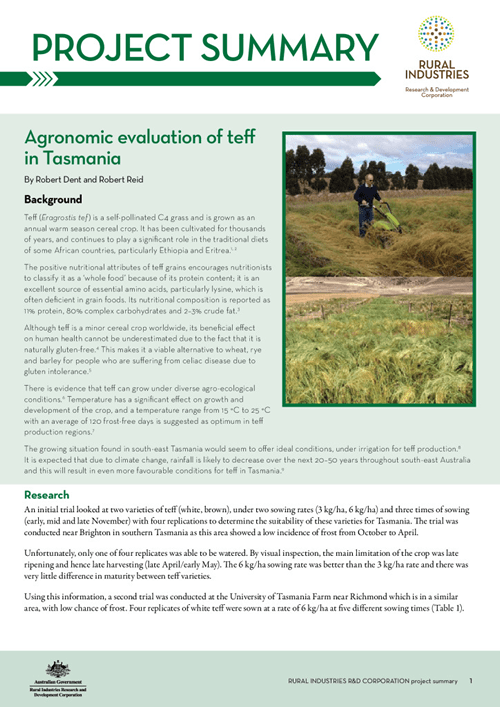Accelerating wattle seed production for the Australian native food industry
The Australian wattle seed (Acacia spp.) industry is poised for significant growth after the establishment of several commercial orchards in recent years. In 2020, about...

Published: 3 Sep 2015
Author(s): Dent, Robert, Reid, Robert
Download report PDF
DownloadTeff (Eragrostis tef) is a self-pollinated C4 grass and is grown as an annual warm season cereal crop. It has been cultivated for thousands of years, and continues to play a significant role in the traditional diets of some African countries, particularly Ethiopia and Eritrea. (D’andrea AC [2008] ‘Tef (Eragrostis tef) in ancient agricultural systems of highland Ethiopia’, Economic Botany 62, 547–566; Degu HD, Ohta M & Fujimure T [2008] ‘Drought tolerance of Eragrostis tef and development of roots’, International Journal of Plant Sciences 169, 768–775).
Although teff is a minor cereal crop worldwide, its beneficial effect on human health cannot be underestimated due to the fact that it is naturally gluten-free (Hopman E, Dekkin G, Blokcan ML & Wuisman M [2008] ‘Tef in the diet of celiac patients in the Netherlands’, Scandinavian Journal of Gastroenterology 43, 277–282). This makes it a viable alternative to wheat, rye and barley for people who are suffering from celiac disease due to gluten intolerance (Vinning G & McMahon G [2006] Gluten-free grains: a demand and supply analysis of prospects for the Australian health grains industry, RIRDC Publication No. 05-011, Rural Industries Research and Development Corporation, Canberra).
There is evidence that teff can grow under diverse agro-ecological conditions (Assefa K, Merker A & Tefera H (1999) ‘Diversity among germplasm lines of the Ethiopian cereal tef’, Euphytica 106, 87–97). It is expected that due to climate change, rainfall is likely to decrease over the next 20–50 years throughout south-east Australia and this will result in even more favourable conditions for teff in Tasmania (Hughes L [2003] ‘Climate change and Australia: trends, projections and impacts’, Austral Ecology 28, 423–443).